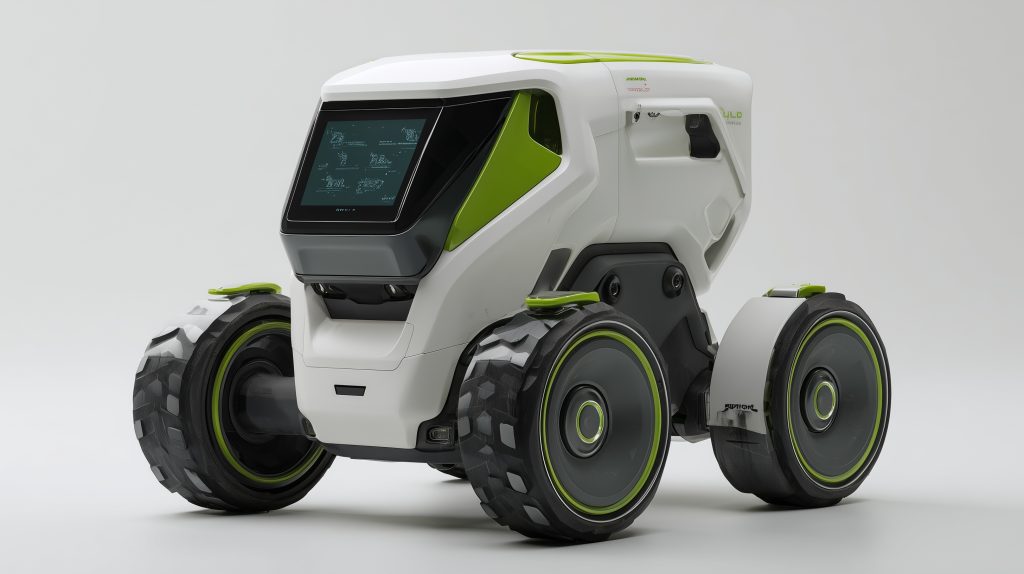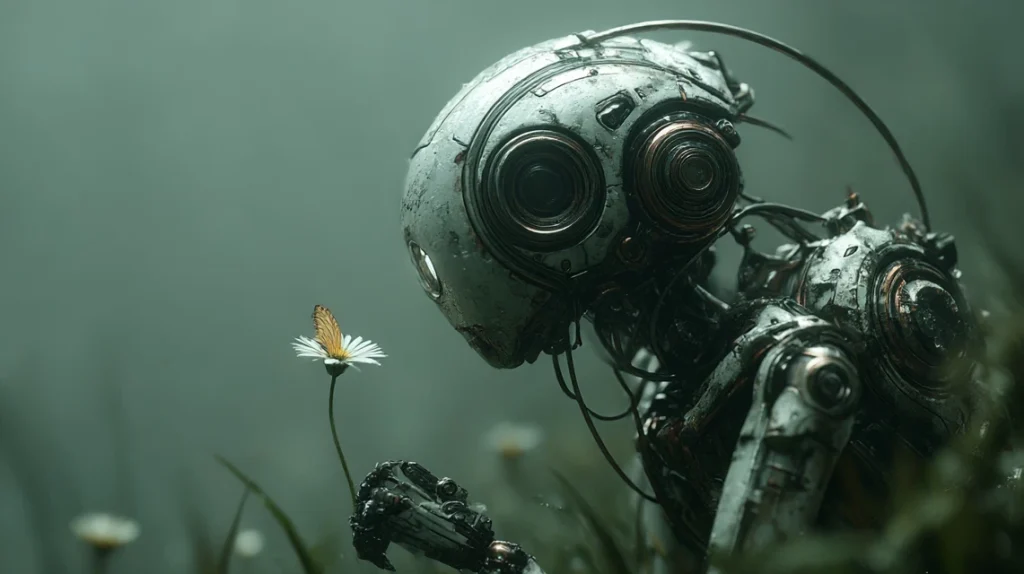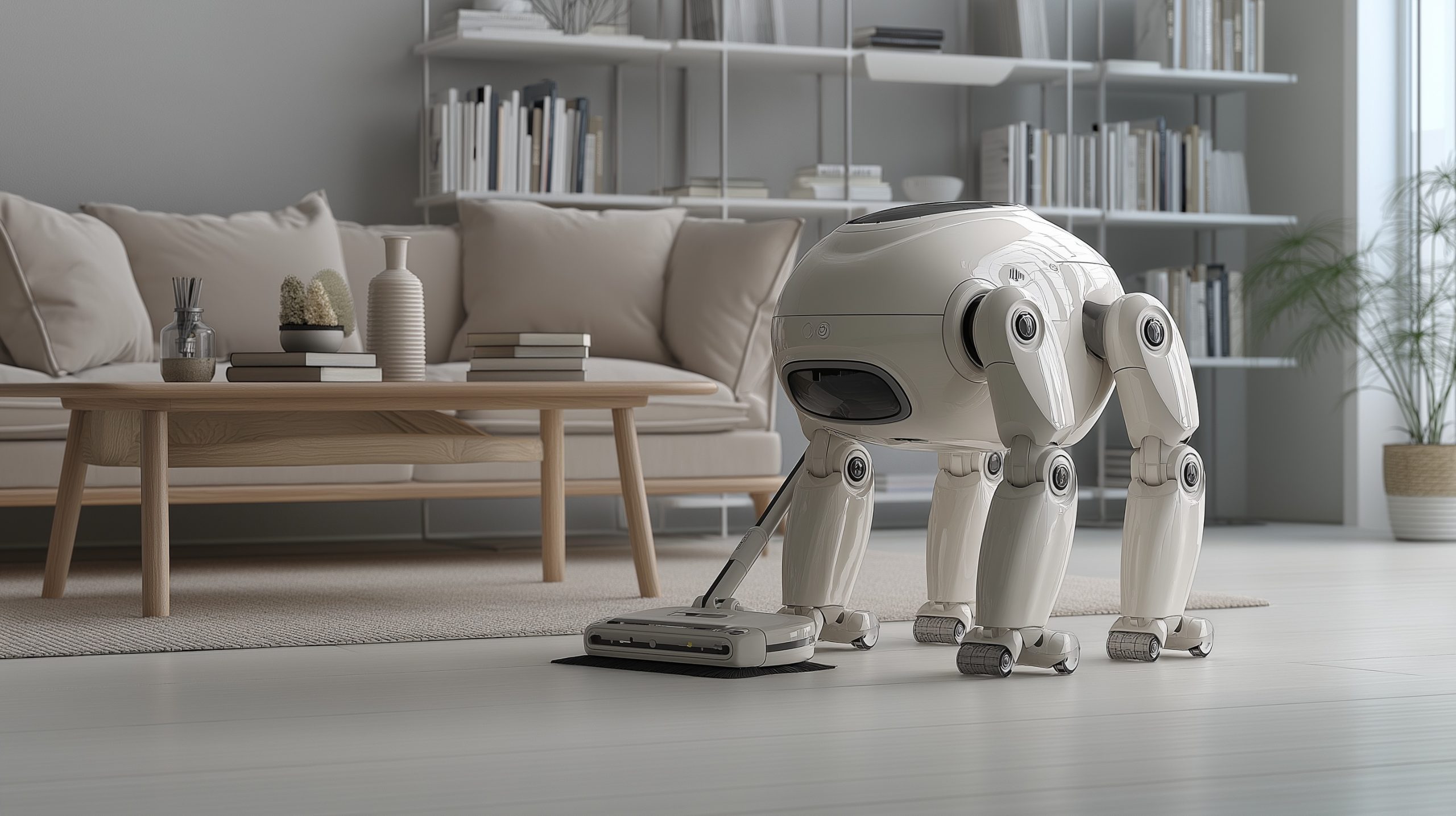By Futurist Thomas Frey
We’re obsessed with humanoid robots. Every tech demo features a machine with two arms, two legs, and a vaguely face-like sensor array. But this obsession with our own form factor might be the biggest design constraint holding back home robotics. The truth is, most household tasks don’t require a human shape—and in many cases, a human shape is exactly the wrong approach.
Nature figured this out millions of years ago. Evolution doesn’t optimize for familiarity; it optimizes for function. An octopus doesn’t need legs. A snake doesn’t need arms. A spider’s eight legs aren’t excessive—they’re precisely what’s needed for its ecological niche. The same logic applies to home robots. The best design for folding laundry might look nothing like the best design for cleaning windows or organizing a garage.
As we stand on the threshold of the home robotics revolution, the most interesting question isn’t “when will robots look like us?” It’s “what shapes will robots need to take to actually be useful?” The answer is far more diverse, creative, and strange than most people imagine.
The Multi-Armed Kitchen Assistant
Picture a robotic system mounted above your kitchen counter—not humanoid, but octopoid. Six articulated arms, each with specialized end effectors, working in coordinated symphony. One arm dices vegetables with precision. Another stirs a pot. A third monitors temperature while a fourth seasons to taste using chemical sensors far more sophisticated than human taste buds.
This isn’t science fiction—the technology exists today. What we call “cooking” is really a collection of simultaneous tasks that humans can barely manage with two hands. We improvise, we multitask poorly, and we burn things because we’re stirring something else. A six-armed kitchen robot doesn’t need to multitask. It can genuinely perform six tasks simultaneously with perfect attention to each.
The design makes sense for other reasons too. Mounted overhead, it doesn’t consume floor space. It doesn’t need legs because it doesn’t need to move—the kitchen comes to it. It doesn’t need a humanoid form because it’s not trying to use human tools; it is the tool. Its arms can be longer, more flexible, and more numerous than ours because it’s not constrained by biology.
Early adopters will be households where cooking is either a passion or a burden that’s eating up hours every day. The system won’t replace the joy of cooking for those who love it—instead, it will handle the tedious prep work while humans focus on creativity and technique. For those who view cooking as a chore, it will simply prepare meals based on dietary preferences and available ingredients.
The Ceiling-Crawler: Gravity-Defying Maintenance
One of the most neglected aspects of home maintenance is everything above eye level. Dusting ceiling fans. Cleaning light fixtures. Changing smoke detector batteries. Removing cobwebs from corners. Cleaning gutters. We avoid these tasks because they require ladders, risk, and contortion.
Enter the ceiling-crawler: a spider-like robot with gecko-inspired adhesive feet that can traverse any surface regardless of orientation. It lives in your attic or a wall-mounted charging station, emerging on schedule or on command to handle elevated maintenance tasks.
The design is brilliant in its simplicity. Eight legs provide stability and redundancy—if one loses grip, seven others maintain contact. Micro-cameras and sensors map three-dimensional spaces. Cleaning attachments swap automatically based on the task. The robot is lightweight enough that even if it falls, it won’t damage floors or hurt anyone below.
This solves a genuine problem, especially for aging homeowners. Falls from ladders kill hundreds of people annually and injure thousands more. A ceiling-crawler eliminates that risk entirely while handling tasks that are otherwise neglected until they become serious problems. When was the last time you cleaned your ceiling fan? Exactly.
The Drawer-Dweller: Modular Organization Systems
Imagine opening your kitchen drawer to find that everything has organized itself overnight. Not because you have a humanoid robot tediously placing items one by one, but because the drawer itself is robotic.
These modular organization systems consist of small, simple robots—each no larger than a bar of soap—that live inside drawers, cabinets, and closets. Using gentle mechanical sorting mechanisms, they gradually reorganize contents based on usage patterns, size, and type. Drop your keys randomly into a drawer, and by morning, they’re in their designated spot.
The genius is in the distribution and specialization. You don’t need one expensive, complex robot trying to organize your entire house. You need fifty cheap, simple robots, each responsible for one cubic foot of space. They don’t need vision systems—they use weight, dimension, and simple pattern recognition. They don’t need mobility beyond their designated container. They work slowly, over hours, so they can be low-power and quiet.
For households drowning in small items—families with children, hobbyists with equipment, anyone who’s ever lost their phone charger in a junk drawer—these systems offer invisible, persistent order. You never see the robots working. You just notice that somehow, inexplicably, everything is always where it should be.
The Snake-Bot: Reaching the Unreachable
Humanoid robots are terrible at accessing tight spaces. They can’t reach behind refrigerators, through ductwork, under low furniture, or into the depths of cluttered closets. These are exactly the places where things get lost, dirt accumulates, and problems hide.
A snake-like robot solves this elegantly. Composed of dozens of articulated segments, it can thread through spaces no human or humanoid robot could access. Equipped with cameras, gripper attachments, and cleaning tools, it retrieves lost items, cleans impossible-to-reach areas, and inspects for problems like leaks, pests, or structural issues.
The applications extend beyond simple retrieval. Homeowners could use snake-bots for routine maintenance inspections—checking under crawl spaces, examining roof interiors, clearing clogged drains from the inside. Plumbers and electricians already use inspection cameras on cables; the next evolution is giving those cables the ability to not just look, but act.
The form factor is particularly valuable for elderly or mobility-impaired households. Dropped something behind heavy furniture? The snake-bot retrieves it without requiring you to move anything. Need to inspect something you physically cannot reach? Send the robot instead of calling for help or risking injury.
The Swarm: Distributed Cleaning Intelligence
Why have one large, complex cleaning robot when you could have one hundred small, simple ones? Swarm robotics applies insect colony principles to household tasks. Each individual robot is barely intelligent—it can detect dirt, avoid obstacles, and communicate with its neighbors. But collectively, the swarm exhibits sophisticated emergent behavior.
Picture this: you spill flour across your kitchen floor. Within seconds, dozens of small robots emerge from baseboard charging stations, converge on the spill, and work together to clean it. Some sweep particles into collection zones. Others vacuum. Still others detect residue and scrub. The task that would take you ten minutes with a broom takes the swarm ninety seconds.
The advantages are numerous. Individual robots are cheap and replaceable. If one breaks, the swarm compensates automatically. They can divide labor based on real-time needs—most of the swarm stays dormant, conserving energy, while only necessary units deploy for each task. They can cover large areas simultaneously or concentrate force on stubborn problems.
For households with pets, children, or high foot traffic, swarm cleaning systems offer continuous, responsive maintenance. The floor is never truly dirty because problems are addressed within minutes of occurring. It’s not scheduled cleaning—it’s ambient cleanliness, maintained by an invisible army of tireless workers.

The Wall-Walker: Vertical Surface Specialist
Windows, mirrors, shower walls, tile backsplashes—homes contain vast expanses of vertical surfaces that require regular cleaning but rarely receive it. A wall-walking robot, using magnetic, suction, or adhesive systems, could autonomously clean all vertical surfaces on a scheduled basis.
Unlike handheld window-cleaning robots that require human placement, an autonomous wall-walker navigates independently. It recognizes different surface types and adjusts cleaning methods accordingly—squeegee for windows, scrubbing for tile, gentle wiping for mirrors. It detects edges to avoid falls and returns to its charging station when finished.
The market for this is enormous. Commercial buildings already use robotic window cleaners, but they’re industrial-scale and expensive. A home-sized version, priced competitively and designed for aesthetic appeal, could transform how we maintain glass and tile surfaces. Imagine never having to clean your shower again—the robot handles it every night after you’re done.
The Laundry Sphere: Rethinking Washing Itself
Current washing machines are essentially the same technology we’ve had for decades—a drum that agitates clothes in water. But what if we designed washing systems around robotic manipulation rather than mechanical agitation?
A laundry sphere system consists of a chamber where individual robotic elements gently manipulate each garment, applying cleaning solutions precisely where needed, detecting stains and treating them individually, and customizing wash intensity for each item. Delicate silk blouses receive different treatment than muddy jeans—simultaneously, in the same load.
The water and energy savings would be substantial. Current washing machines treat all clothes identically, using far more water and detergent than necessary for lightly soiled items while under-treating heavily soiled areas. A robotic system could optimize resources for each garment individually.
This reimagines laundry not as a batch process but as an individualized service. The machine becomes less like an appliance and more like a very patient, thorough human hand-washing each item. The form factor is completely different from current washers—possibly spherical, possibly modular, but definitely not a drum.
The Garden Gnome: Outdoor Plant Management
Gardening robots don’t need to be humanoid—they need to be weatherproof, patient, and specialized. The garden gnome robot (yes, manufacturers will absolutely lean into this aesthetic) is a low-profile, wheeled platform that monitors soil conditions, identifies plants and weeds, and provides targeted care.
Unlike traditional sprinkler systems that water indiscriminately, garden robots deliver precise amounts of water to individual plants based on species, size, soil moisture, and weather predictions. They identify weeds early and remove them mechanically, without herbicides. They monitor for pests and diseases, alerting homeowners to problems before they become serious.
The design prioritizes durability and autonomy over speed. The robot works slowly, methodically, covering the garden over hours or days. It operates in rain, sun, and darkness. It recharges via solar panels built into its housing. It’s essentially a very intelligent, mobile irrigation system with eyes and hands.
For homeowners who want gardens but lack time or mobility to maintain them, these robots offer a middle ground between hiring landscapers and letting nature take over. The garden becomes a managed system rather than a constant battle.
The Furniture That Thinks: Embedded Intelligence
Perhaps the most radical departure from humanoid robotics is making the home itself robotic. Why have robots interact with furniture when the furniture could be the robot?
A robotic bed adjusts firmness and temperature based on sleep patterns, gently wakes you at optimal sleep cycle moments, and even helps with morning stretches through subtle mechanical assistance. A robotic couch shifts configuration based on who’s sitting and what they’re doing—movie mode, reading mode, nap mode—without anyone touching a control.
Robotic shelving systems reorganize themselves for optimal accessibility, bringing frequently used items to easy-reach zones while moving rarely-used items to higher shelves. Kitchen cabinets that present the dish you need before you ask for it. Desks that adjust height, lighting, and monitor position throughout the day based on posture and task.
This is robotics as environmental intelligence rather than separate machines. The home becomes a responsive, adaptive space that anticipates needs and adjusts accordingly. It’s not about robots living in your home—it’s about your home becoming quietly, helpfully alive.
The Modular Toolbox: One Robot, Many Forms
Rather than buying separate robots for different tasks, imagine a modular system where a central processing unit connects to different body configurations based on need. Today it’s a floor cleaner. Tomorrow you reconfigure it into a window washer. Next week it becomes a garden assistant.
This approach solves the economics problem plaguing home robotics. Instead of spending $20,000 on five specialized robots, you spend $8,000 on one intelligent core and $2,000 on each attachment set. The expensive part—the AI, sensors, and computing power—is reused across applications.
The modular approach also future-proofs your investment. New attachments will be developed over time, expanding capabilities without replacing the entire system. Software updates improve intelligence across all configurations. When the core unit eventually needs replacement, all your attachments remain compatible with newer models.
Think of it like a computer versus a typewriter. A single general-purpose computer running different software replaced dozens of single-purpose machines. Modular robotics applies the same logic to physical tasks.

The Trash Tracker: Waste Management Intelligence
We produce garbage constantly, but managing it is still surprisingly primitive—we walk trash to bins, forget which items are recyclable, and miss pickup days. A robotic waste management system could handle the entire chain autonomously.
Small robots stationed near common waste generation points (kitchen, bathrooms, garage) automatically collect and sort waste. They identify recyclables using computer vision, separate organics for composting, and flag hazardous materials. They consolidate trash into bins and move those bins to the curb on collection days, then retrieve empty bins afterward.
The form factor would be low-profile and utilitarian—basically smart waste containers that can move themselves. They don’t need arms or legs, just wheels, sensors, and sorting mechanisms. For households trying to reduce environmental impact, these systems eliminate the excuse of “recycling is too complicated” by making it completely automatic.
The Pet Shadow: Animal-Specific Assistance
Rather than general-purpose pet care robots, imagine species-specific designs optimized for particular animals. A cat companion robot that initiates play using hunting-mimicry patterns, ensuring your indoor cat gets proper exercise. A dog robot that walks beside your pet in the backyard, monitoring health metrics and adjusting play intensity accordingly.
These wouldn’t look humanoid—they’d look appropriate for their animal audience. The cat robot might be a small, quick-moving toy-like object that triggers prey drive effectively. The dog robot might be a durable, weather-resistant rolling companion with attachment points for leashes and treat dispensers.
The advantage is specialization. A robot designed specifically for cats can be optimized for feline psychology and behavior in ways a general-purpose robot never could. It speaks the animal’s language through movement, timing, and interaction patterns evolved specifically for that species.
The Implications of Form Diversity
When we move beyond humanoid obsession, the home robotics landscape becomes far more diverse and interesting. Different tasks require different forms, and that diversity brings several advantages:
Specialization enables excellence. A robot designed specifically for cleaning windows will always outperform a general-purpose humanoid trying to do the same task. Evolution proved this—specialists dominate their niches.
Cost comes down. Simple, specialized robots are cheaper to manufacture than complex humanoid systems. A $500 wall-walker is an easier purchase decision than a $20,000 general-purpose robot.
Deployment accelerates. It’s easier to perfect one task than to perfect everything. We’ll see functional specialized robots years before we see competent generalists.
Acceptance increases. People might be uncomfortable with humanoid robots in their homes but perfectly comfortable with specialized appliances. A ceiling-crawler doesn’t trigger the uncanny valley—it’s just a useful tool with legs.
Innovation flourishes. When designers aren’t constrained by human form factor, creativity explodes. The best solutions to household problems might look completely alien—and that’s perfect.
Final Thoughts
The future of home robotics won’t be a single humanoid butler handling all tasks. It will be a diverse ecosystem of specialized machines, each optimized for specific functions, many bearing little resemblance to human form.
Your home in 2035 might contain: a six-armed kitchen system, a ceiling-crawler for high maintenance, drawer-organizing modules, a snake-bot for retrieval, a cleaning swarm, a wall-walker for windows, a garden gnome, smart furniture, and a modular core robot that reconfigures for different tasks. Not one of these resembles a human, yet together they handle nearly every household task that currently consumes your time.
We’ve been asking the wrong question. It’s not “when will robots look like us?” It’s “what should robots look like to actually be useful?” The answer is as diverse as the tasks we need them to perform.
The robotics revolution won’t be humanoid. It will be beautiful, strange, and wonderfully functional—a menagerie of specialized machines that blend into our homes not by mimicking us, but by solving problems in whatever form works best.
Form should follow function. Evolution understood this. It’s time robotics caught up.
Related Links:
Biomimetic Robotics: Learning from Nature’s Designs
The Economics of Specialized vs. General Purpose Home Robots
Swarm Intelligence in Consumer Robotics Applications


